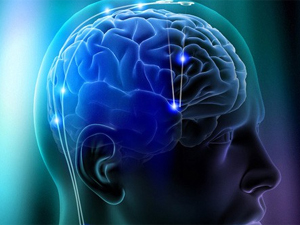



Date:02/10/18
 Neuroscientists have successfully connected up a three-way brain connection to allow them share thoughts. Researchers have built a system called ‘BrainNet’ which allows an actual exchange of thoughts between the brains. Earlier researches show that it is possible for two people to collaborate to a limited extent using brain waves to play a video game. In this new effort, the researchers have extended the idea to include a third person.
Neuroscientists have successfully connected up a three-way brain connection to allow them share thoughts. Researchers have built a system called ‘BrainNet’ which allows an actual exchange of thoughts between the brains. Earlier researches show that it is possible for two people to collaborate to a limited extent using brain waves to play a video game. In this new effort, the researchers have extended the idea to include a third person.
Using BrainNet, the participant group is able to play a collaborative Tetris-like game. The network uses a combination of electroencephalograms to record electrical activity and transcranial magnetic stimulation to send info.
"We present BrainNet which, to our knowledge, is the first multi-person non-invasive direct brain-to-brain interface for collaborative problem solving," researchers write.
BrainNet works through a combination of electroencephalograms, for recording the electrical impulses that indicate brain activity, and transcranial magnetic stimulation, where neurons are stimulated using magnetic fields. BrainNet requires external intervention. It can only send one bit of data at a time. However, in future, it can be scaled up to transmit more complex thoughts across groups.
The precursor to BrainNet was a gear that University of Washington researchers used in 2015 to connect two people through a brain-to-brain interface. In its modern avatar, BrainNet allows three people to join a conversation using brain-to-brain network, Engadget reported.
The researchers suggest there is no reason BrainNet could be expanded in future to include desired number of people.
Scientists connect three human brains enabling them to share thoughts
 Neuroscientists have successfully connected up a three-way brain connection to allow them share thoughts. Researchers have built a system called ‘BrainNet’ which allows an actual exchange of thoughts between the brains. Earlier researches show that it is possible for two people to collaborate to a limited extent using brain waves to play a video game. In this new effort, the researchers have extended the idea to include a third person.
Neuroscientists have successfully connected up a three-way brain connection to allow them share thoughts. Researchers have built a system called ‘BrainNet’ which allows an actual exchange of thoughts between the brains. Earlier researches show that it is possible for two people to collaborate to a limited extent using brain waves to play a video game. In this new effort, the researchers have extended the idea to include a third person.Using BrainNet, the participant group is able to play a collaborative Tetris-like game. The network uses a combination of electroencephalograms to record electrical activity and transcranial magnetic stimulation to send info.
"We present BrainNet which, to our knowledge, is the first multi-person non-invasive direct brain-to-brain interface for collaborative problem solving," researchers write.
BrainNet works through a combination of electroencephalograms, for recording the electrical impulses that indicate brain activity, and transcranial magnetic stimulation, where neurons are stimulated using magnetic fields. BrainNet requires external intervention. It can only send one bit of data at a time. However, in future, it can be scaled up to transmit more complex thoughts across groups.
The precursor to BrainNet was a gear that University of Washington researchers used in 2015 to connect two people through a brain-to-brain interface. In its modern avatar, BrainNet allows three people to join a conversation using brain-to-brain network, Engadget reported.
The researchers suggest there is no reason BrainNet could be expanded in future to include desired number of people.
Views: 383
©ictnews.az. All rights reserved.Similar news
- Azerbaijani project to monitor disease via mobile phones
- Innovative educational system to be improved under presidential decree
- NTRC prolongs license of two TV and radio organizations for 6 years
- Azerbaijan establishes e-registry for medicines
- Azerbaijani museum introduces e-guide
- Nar Mobile opens “Nar Dunyasi” sales and service center in Siyazan city
- International conference on custom electronic services held in Baku
- OIC secretary general to attend COMSTECH meeting in Baku
- Azerbaijan develops earthquake warning system
- New law to regulate transition to digital broadcasting in Azerbaijan
- Azerbaijani State Social Protection Fund introduces electronic digital signature
- Intellectual traffic management system in Baku to be commissioned in December
- Tax Ministry of Azerbaijan started receiving video-addresses
- World Bank recommends Azerbaijan to speed up e-service introduction in real estate
- Azerbaijan to shift to electronic registration of real estate





















